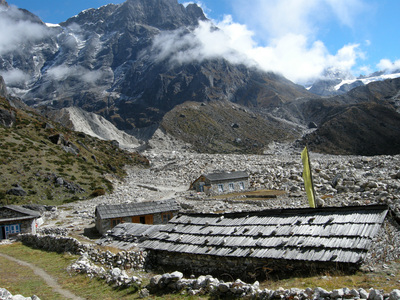
Khumbu's glaciers


Glaciers, glacial lakes and GLOF’s
 |
Tangnang (Hinku Valley, Nepal)
|
Glaciers, glacial lakes and GLOF’s
The Khumbu is home to several big glaciers, which include glacial lakes. This has been the impact of global climatic change, which has caused several changes in the high mountainous environment. These changes, such as global warming, of which about 50% is caused by human sources (greenhouse effect), made many of these big glaciers melt rapidly and caused, in this way, the forming of several glacial lakes.
Studies show that most of the glacial lakes have formed during the last 50 years of the past century. In general, the lakes are becoming bigger and are also increasing in number, as the glaciers are gradually melting away.
Due to the faster rate of ice and snow melting, the accumulation of water in these lakes has been increasing rapidly.
The drainage of these large moraine-dammed lakes is a big threat to the local population, causing significant environmental hazards in the Himalayan valleys. Due to the weak natural dams, a sudden discharge of large volumes of water and debris could cause floods. In recent decades, there have been several so called Glacial Lake Outburst Floods (GLOF's), which have caused widespread damage to homes, roads, bridges and industry, destruction of farmland, and loss of life. Many more potentially unstable lakes have been identified up-valley in populated regions, and some are the subject of engineering projects to lower their levels and mitigate GLOF hazards. Mitigation works, however, are both expensive and logistically difficult in these badly accessible high altitude environments.
In the Himalayas, large ice-contact lakes form in association with pebble and rock covered glaciers, which behave differently to normal, clean glaciers. Such debris-covered glaciers deposit massive ridges of debris - moraines - around their snouts. They are capable of ponding large volumes of melt water, but lack the mechanical strength to hold the water for a longer period. Furthermore, a thick cover of debris on the glacier inhibits melting, thus delaying the response of the glacier to global warming.
It is as if the glaciers have 'stored' their response to climate change, and are only now catching up with over a century of rising temperatures. It is possible that many large Himalayan valley glaciers are currently so far out of balance with the climate that they may cross the threshold into rapid lake growth in the coming decades, even if the recent warming trend should end.
There is therefore a growing need for a long term view of evolving glacier hazards in the region, based on a sound understanding of the life cycle of these glaciers and their response to global warming.
In South Asia, particularly in the Himalayan region, it has been observed that the frequency of the occurrence of GLOF events has increased in the second half of the twentieth century. The recent catastrophic GLOF event in the Nepal Himalayas, known as the Dig Tsho GLOF in 1985, destroyed the Namche small hydro-electric project that was built at the cost of approximately US$ 1.5 million. Accurate and timely information on the spatial locations and regular monitoring of the glacial lakes' behaviour is needed, in order to prevent and monitor the GLOF hazards, and assess the damages that could occur in the near future. Modern information tools, such as remote sensing and GIS, could play a leading role in identifying potential risk lakes and monitoring the GLOF events in near real-time.
Several institutions and researchers are developing and establishing an operational warning system to monitor GLOF hazards.
Last update: 16 April 2013

 |  | 
Monitoring of glaciers in the Himalayas

| | • | Introduction (http://www.esa.int/SPECIALS/Eduspace_Global_EN/SEM3TN0SAKF_0.html) |  | | • | Glaciers (http://www.esa.int/SPECIALS/Eduspace_Global_EN/SEM93O0SAKF_0.html) |  | | • | Investigation area (http://www.esa.int/SPECIALS/Eduspace_Global_EN/SEM69O0SAKF_0.html) |  | | • | Imja glacier (http://www.esa.int/SPECIALS/Eduspace_Global_EN/SEMCHO0SAKF_0.html) |  | 
Exercises

| | • | Location of the study area, Khumbu Himal (http://www.esa.int/SPECIALS/Eduspace_Global_EN/SEM3SO0SAKF_0.html) |  | | • | Development of glacial lakes in the Khumbu Himal (http://www.esa.int/SPECIALS/Eduspace_Global_EN/SEM1AP0SAKF_0.html) |  | | • | Glacier retreat at Honku glacier (http://www.esa.int/SPECIALS/Eduspace_Global_EN/SEM2EP0SAKF_0.html) |  | 
Links

| | • | Further Reading (http://www.esa.int/SPECIALS/Eduspace_Global_EN/SEM9HP0SAKF_0.html) |  | 
Eduspace - Software

| | • | LEOWorks 3 (http://esamultimedia.esa.int/multimedia/LEOWorks3.exe) |  | 
Eduspace - Download

| | • | glacier_worksheet1.zip (http://esamultimedia.esa.int/docs/eduspace/glacier_worksheet1.zip) |  | | • | glacier_worksheet2.zip (http://esamultimedia.esa.int/docs/eduspace/glacier_worksheet2.zip) |  | | • | glacier_worksheet3.zip (http://esamultimedia.esa.int/docs/eduspace/glacier_worksheet3.zip) |  |

|

